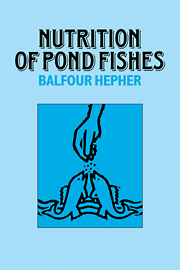Book contents
10 - Supplementary feed and its utilization
Published online by Cambridge University Press: 06 August 2010
Summary
Kinds of supplementary feed
Supplementary feed can be classified according to several criteria. Classification by energy and protein contents is quite common since energy-rich feedstuffs, such as cereals, are usually poor in protein, while those rich in protein, such as tissue meals and oil meals, are often poor in energy. Feeds can also be classified into ‘natural’, such as grains, grasses etc., and ‘processed’, such as meals or yeasts. However, from the standpoint of nutrition, the most signficant classification is that of simple feedstuffs and compounded ones, because of the greater availability of the former, but the greater ability to control feed composition with the latter.
Simple feedstuffs are usually homogeneous, although their nutrient content may vary widely according to their origin. Thus, fishmeal of different species and production processes may contain 40–74% protein, and protein and energy contents of oil meals may vary according to the oil extracting process. The most important advantage of simple feedstuffs is their availability even in areas where industry is scarce. Because of the abundance of some simple feedstuffs in certain areas, such as rice-bran and broken rice in South East Asia, or sorghum in tropical regions, it is of relatively low cost in comparison to other feedstuffs. Many of the simple feedstuffs are agricultural by-products such as rice-bran, broken rice or relatively inexpensive grains such as sorghum. Even grass is used as fish feed in certain areas (mainly China) and for certain fish (mainly grass carp, Ctenopharyngodon idella).
- Type
- Chapter
- Information
- Nutrition of Pond Fishes , pp. 292 - 306Publisher: Cambridge University PressPrint publication year: 1988
- 1
- Cited by



